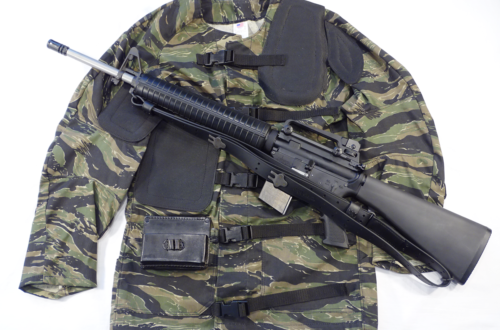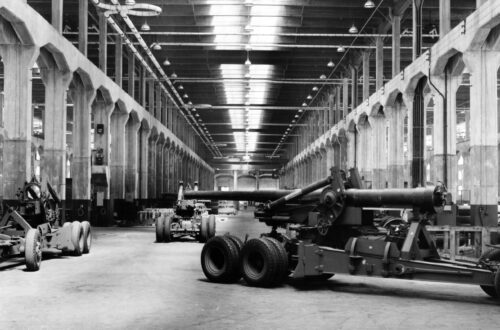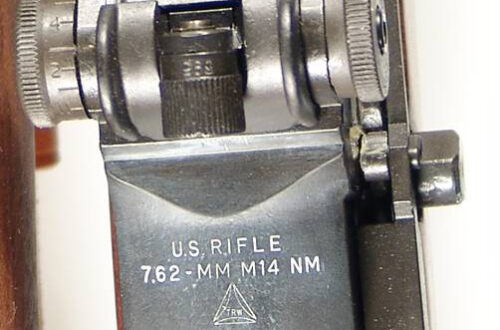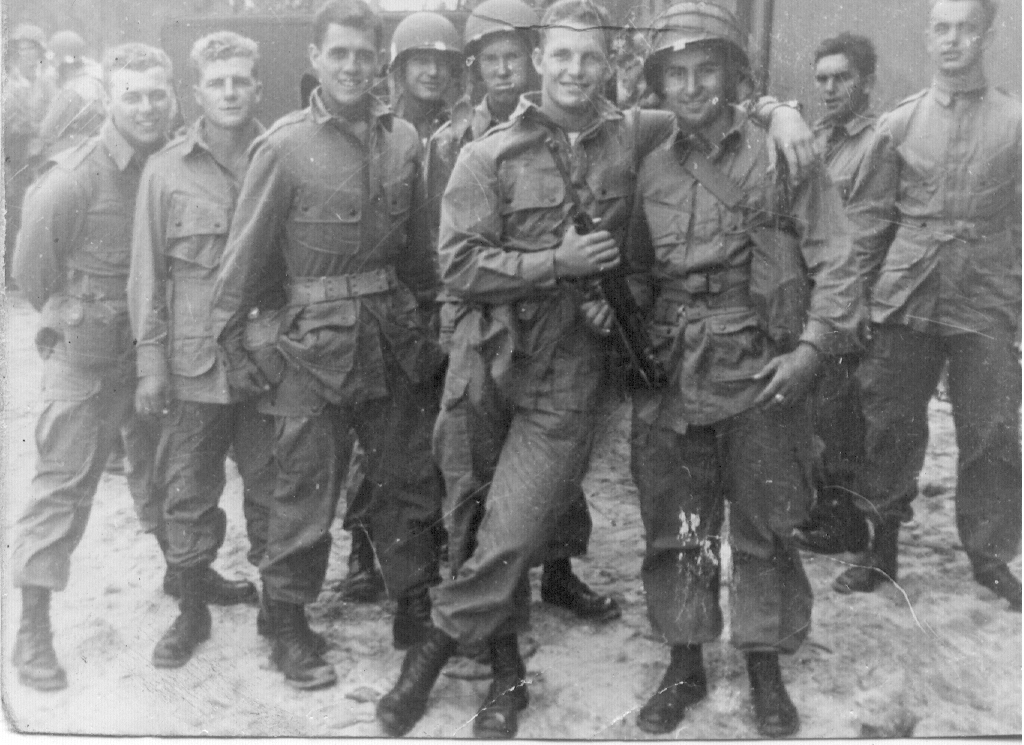
“US Infantry Weapons in Combat – Personal Experiences from World War II and Korea”
When in 1992 I learned that my future father-in-law, Thomas Shoen, Jr., had been a paratrooper in World War II I had to add an M1A1 carbine, jump boots, and a M1942 jump suit to my collection. In conversations with fellow collectors I have found that many of us collect the firearms and accoutrements that we do because our dad, grandfathers, or uncles carried them in World War II or Korea. With that motivation it quickly becomes a personal quest to collect these artifacts as a way to honor their sacrifices for our freedom and in their memory. – Scott Duff
Thomas Shoen, Jr. was drafted into the Army in 1943 on his 19th birthday. He reported to Ft. McArthur, CA and volunteered for paratrooper training. He was assigned to the 11th Airborne Division and sent to Cp. MacKall, NC. Mr. Shoen received jump training at Ft. Benning and qualified as a paratrooper on June 10, 1943. After additional training in the US, the 11th left the US in May 1944, setting sail for New Guinea. The 11th Airborne Division entered combat in November 1944 with the invasion of the island of Leyte in support of the liberation of the Philippine Islands. Mr. Shoen was wounded on Leyte in December 1944. He returned to combat on the island of Luzon in February 1945 where he made two combat jumps and participated in the liberation of Manila. He returned to the US and was discharged in December 1945.
I enlisted in the Army right after Pearl Harbor. I was only 17 and lied about my age; I wanted to go fight the Japs or the Germans. My mother found out where I was and turned me in. She brought me back home and made me finish high school. I was drafted on February 7th 1943, my 19th birthday. We were sent home for one week to tie up our affairs. On February 15th 1943, I reported to Ft. McArthur and was sworn into the Army. While at McArthur, they asked for volunteers to become paratroopers, so two of my buddies and me volunteered. Two of us were assigned to the 11th Airborne Division and the other guy to the 101st Airborne. We were transported from California to Toccoa, GA by train. I was only at Toccoa for one day. This was where we were assigned to units. I was assigned to the 2nd Platoon, Company C, 127th Airborne Engineer Battalion. We were transported by truck to Cp. MacKall in North Carolina. That winter at MacKall was very cold with many ice storms. Growing up in southern California, it was the first time I ever saw snow or ice. Those tarpaper-covered barracks sure let a lot of cold wind blow through.
We got our M1 rifles during our second month at Cp. MacKall. They were new rifles in the Cosmoline. We spent all day cleaning them and learning the nomenclature of the parts. The M1 Garand was the first weapon I qualified with; I liked that rifle a lot. It sure would shoot and it never malfunctioned if you maintained it properly. I qualified expert with it. In fact, every man in the 127th qualified expert. We were told beforehand that anyone who qualified expert would get a 10-day furlough. The way it worked was A Company scored for B Company and Headquarters Company scored for C Company. Then we switched, B scored for A and C for HQ. We all qualified as experts! Colonel Davis, our battalion CO, said that we were the only battalion that had accomplished that. I went to New York City on my furlough, because 10 days wasn’t enough time to get home to California and back.
We also qualified with the M1 Carbine. Later, when we started jump training, we were issued folding stock carbines. The only other weapon that I officially qualified with was the .45 pistol; now that was some gun. It did a real good job for me later on. Some guys qualified with the BAR and some with the Thompson. I never qualified with either, but I shot them both.
In training, we mostly jumped with the folding stock paratrooper carbine. You could either just sling it around your neck and go or you could put it under your reserve chute, sandwiched in next to your body. But when the chute opened, the gun would come up and the pistol grip hit you under the chin. It hurt pretty good! I recently heard that they had a canvas “holster” for the folding stock carbine. They may have had those in Europe, I don’t know, but I never saw one in the Philippines. I also saw a carbine a few years ago that had an adjustable rear sight and a bayonet lug. We never had those either.
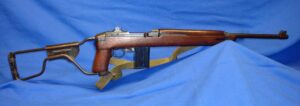 As engineers, our primary job was mostly to blow things up, demolition and that sort of thing, that and clearing mines. We also would walk in front of the tanks so they wouldn’t run over a mine. The mines weren’t too tough to spot, so it wasn’t as dangerous as it sounds. But when you were out there you just knew that every Jap rifle in the jungle was aimed at you and that you’d be the first one to get shot. You’d stay out there for about 10 or 15 minutes at a time, then you’d rotate back behind the tank and someone else would take a turn out front. But that was almost as bad, because now one of your buddies might get shot. It was tough on the nerves being out in front of one of those Shermans!
As engineers, our primary job was mostly to blow things up, demolition and that sort of thing, that and clearing mines. We also would walk in front of the tanks so they wouldn’t run over a mine. The mines weren’t too tough to spot, so it wasn’t as dangerous as it sounds. But when you were out there you just knew that every Jap rifle in the jungle was aimed at you and that you’d be the first one to get shot. You’d stay out there for about 10 or 15 minutes at a time, then you’d rotate back behind the tank and someone else would take a turn out front. But that was almost as bad, because now one of your buddies might get shot. It was tough on the nerves being out in front of one of those Shermans!
Company C was the only fully jump qualified engineer company in the 11th. General Swing wanted everybody to cross-train between parachuting and gliders. I made a couple of landings in a glider while we were still in North Carolina, one with a little bulldozer on board the glider. I never wanted to do that again! I’d take a parachute any day. Company C was attached to the 511th Parachute Infantry Regiment during most of our time in the Philippines. We often fought as infantry and saw a lot of action. I was in six major battles. During the taking of Manila, we were on the line for 31 days straight. The 127th and the 511th took shifts in the foxholes to give each other a chance to get some sleep.
When we shipped overseas, our equipment, including weapons, were packaged for shipment on the ships with us; we didn’t carry them on board. A lot of us engineers worked as stevedores in New Guinea unloading our equipment. Most airborne engineers were issued either a standard carbine or the folding stock paratrooper carbine, but I didn’t like them too much. They were no good in the Philippines where we fought. The heavy jungle would deflect or even stop the bullets and they just didn’t hit hard enough. If you hit a Jap, he just might get back up! I saw them take three or four rounds from a carbine and just keep coming. I got rid of my carbine for the first Garand I could. I sure liked that M1 rifle; when you shot them with a Garand, they stayed down. I never had any problems with the M1’s I used. They always worked; they were a heck of a rifle. I liked the .45 pistol too; I carried one whenever I could. They weren’t issued to us, but we found ways to get them. When you shot a Jap with a .45, the hole going in was as big around as your finger and the one coming out the other side was four times bigger! Most Japanese weren’t very big to start with; they sure didn’t get up after that!
On the evening of December 6th 1944, we were hit by the only Japanese parachute assault on US troops during the entire war. We were at San Pablo Airstrip on northern Leyte. I had just finished cleaning up my mess kit after dinner when we saw the planes coming over and the parachutes opening. It took us a few minutes to realize what was going on. We fought through the night and I was wounded in the morning of the next day, December 7th while we were retaking the airstrip. I was hit in both legs and the right arm by shrapnel from a hand grenade that was rolled at me. I used my Garand to kill the Jap that rolled that grenade. They evacuated me by ship to New Guinea. I was on the operating table for three hours and they removed 33 pieces of shrapnel from me. I received a Purple Heart while in the hospital in New Guinea.
I returned to my unit on February 22nd 1945. They had moved on to Luzon by then. My first combat jump was on Tagaytay Ridge on southern Luzon in the Philippines on February 23rd. It was one day after I got back from New Guinea after recovering from being wounded. My second jump was on June 23rd in northern Luzon, south of Aparri, Operation Gypsy Task Force. I was armed with a Garand rifle on both jumps. I carried my M1 disassembled and in a canvas case, I think it was called a Griswold bag. You assembled the rifle after you landed. I carried the bag sandwiched behind my reserve chute. We had bayonets, but I always carried a trench knife too. I kept one shoved down in my boot, tied to my lower leg. I never went anywhere without one.
I sure was glad when the war ended. If it weren’t for the atomic bomb, I probably wouldn’t be here. I fought in six battles, I doubt I would have survived the seventh one; it saved my life and the lives of many of my buddies. When the war ended, we were in northern Luzon. They flew us to Okinawa first and re-outfitted us, new uniforms and so on. It was the first time I ever landed in an airplane. I’d made 17 takeoffs without a landing! The 11th were the first US troops to set foot on Japan. Our company landed near Yokohama on August 28th 1945. As engineers, in preparation for General MacArthur’s arrival, one of our first jobs was to check the roads and bridges along his planned travel route for mines and explosives. Later, they moved the 127th to Sendai, Japan for occupation duty.
I left Japan by ship in December 1945. It only took seven days to get home. That was a lot better than on the way over when it had taken us 31 days to get to New Guinea because of zigzagging to dodge Jap submarines. After arriving back in the States, I was discharged on December 17th 1945. The thought of losing the war never entered our minds. It wasn’t “if” we would win, it was “when” we would win. We were trained to believe that we couldn’t be beat and that we could do anything. It probably served us well after we came home from the war. We still thought that we could do anything.
By Mark G. Goodwin
If you would like to read more stories about weapons in combat, check out our website. We offer several Bundles at a reduced price.
This book is included in the US Infantry Book Bundle or you can purchase the book by itself here: US Infantry Weapons in Combat


